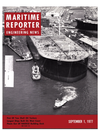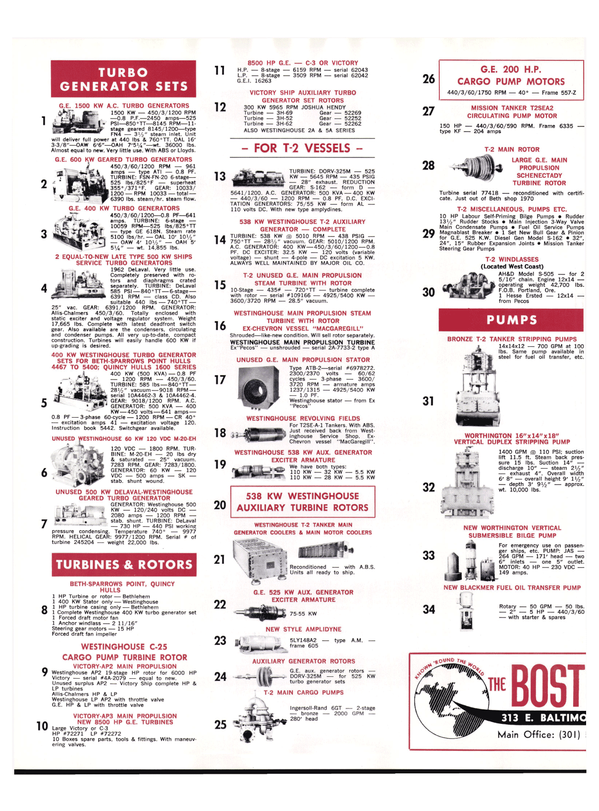
Perspectives On Third World Port Development
Within the last decade, containerization has transformed the appearance and operations of many ports in the developed world and has established a dominant position on virtually all deepsea general cargo routes between industrial nations. Despite some significant developments recently on routes to the Caribbean and Middle East, its impact on the ports and trade of the Third World generally remains limited.
There are widespread doubts on the applicability of this sophisticated, capital-intensive system to the needs and resources of less developed countries, and the spread of containerization into the Third World arena is being fiercely resisted by more conventional forms of shipping (and in the Middle East by ro/ro). The most likely challenger on many routes is the modern multipurpose vessel — c o m b i n i n g costsaving series production with trading flexibility. Western shipowners and Third World national lines alike are confirming their faith in the future of these modern successors to earlier conventional tonnage by ordering them in large numbers. Will multipurpose ships succeed in halting the spread of container systems to the Third World? Or will the sceptics again be confounded (as they were by the rapid advance of containerization in the Western World a few years ago) ?
These and related questions are of great interest to investors, vessel operators and Third World port authorities and governments.
"Perspectives on Third World Port Development," the latest in a long line of studies from HPD Shipping Publications, examines the factors involved and seeks to provide some answers.
Part I of the study reviews current problems in Third World ports, including congestion which, while it has been most dramatic in OPEC ports, is proving to be more endemic and long-lasting in the ports of the poorer developing countries. Congestion, to which under-investment is a contributing factor, is matched on the other side by the dangers of investing in the wrong sort of port facilities or of committing large amounts of capital too soon—e.g., to specialized container terminals which may remain grossly underutilized for several years. Either mistake can have near disastrous consequences for a developing country's trade and economic development.
To establish the correct context for decisions on port investment and appropriate shipping technologies, the report reviews distinguishing features of Third World general cargo trade, existing port facilities, capital and labor endowments, inland transport i n f r a s t r u c t u r e , and planning and managerial resources.
In Part II, the report goes on to compare the two main contenders for the deepsea general cargo traffic of developing countries— modern multipurpose shipping and fully cellular systems.
Semi-containerships (an intermediate l i f t - o n / l i f t - o f f shipping mode) are also examined. The significant features of each system are analyzed, including vessel characteristics and costs, compatibility with Third World trade flows, and drafts compared with depths of water in Third World ports. Port terminal requirements and costs are contrasted. One finding is that the level of containerizable traffic required to justify individual cellular services is considerably below that justifying investment in a specialized container terminal. The potential contribution of multipurpose berths, and other ways of bridging this gap—common in Third World ports—are assessed.
The report identifies the current stage of container terminal development in developing countries and reviews plans for further cient inland transport. Delays in returning containers to the port can easily make the whole system uncompetitive through their effect on the required box:containership slot ratio. Other factors, such as trade imbalances and consequences of containerization for port employment may be less of a constraint than is commonly supposed. The report contrasts the implications of containerization and multipurpose shipping for inland transport, dock labor and port planning and management.
Developing countries are frequently criticized for investing too much in national fleet development and not enough in improved port facilities. Part III of the study investigates the facts behind this apparent bias and reveals the crucial importance of the distribution of benefits from port investment. Most of the benefits from improved port facilities flow initially to vessel operators who may see cargohandling costs and turnaround times for existing ships reduced, or may be able to operate larger, more sophisticated vessels (such as containerships) as a consequence of the port improvements.
Developing countries may shun major port investment, with its sizable demands on limited capital resources and possible adverse effects on port employment, unless they are assured of a share of the overall benefits which the investment brings. This will principally depend on port pricing policies, the rate-making practices of liner conferences and market elasticities—all topics which are covered in this 90-page study, which concludes by suggesting how the right balance between general cargo ports and shipping investment can be achieved.
"Perspectives on Third World Port Development," No. 54 in a series of reports on various aspects of shipping prepared by the Research Division of HPD Shipping Publications, 34 Brook Street, Mayfair, London W1Y 2LL, England, is available at a single copy rate of U.S. $75, or on a subscription basis at U.S.
$275 for the current series of reports Nos. 51-60.
specialized f a c i l i t i e s . Another finding is the importance of effi-
Read Perspectives On Third World Port Development in Pdf, Flash or Html5 edition of September 1977 Maritime Reporter
Other stories from September 1977 issue
Content
- Lloyd's To Class Two Large Crane Barges To Be Built By Mitsui page: 4
- Estimated Foreign Cost Of Two LNG Carriers $115.5 Million Each page: 6
- McAllister Brothers Name Robert Lounsbery Chief Operating Officer page: 7
- Lockheed Wins Contract To Evaluate Ocean Platform Candidates page: 7
- Bethlehem Steel Names G.Y. Marriner Manager San Francisco Yard page: 7
- AMPAC To Build Four Container Feeder Ships At Cost Of $92 Million page: 7
- MarAd Approves Title XI For Five Moran Tugboats page: 8
- SNAME New York Section Announces Program For 1977/1978 Season page: 8
- Willamette Awarded $15 Million To Modernize Alaska State Ferry page: 9
- Marathon Manufacturing Adds $61 Million To Drilling Rig Backlog page: 9
- NASSCO Building 188,500-DWT Tankers For Alaskan Oil Trade page: 10
- Exxon Begins Operating Remote Sea-Floor Production System page: 10
- Propeller Club Convention Includes Shipyard Panel page: 11
- MacMillctn Bloedel Orders Log Carrier At Cost Of $14 Million page: 12
- C-E Names Matthews Manager Of Contracts, Marine Power Systems page: 12
- Role Of Ro/Ro Shipping In Dry Cargo Trade page: 12
- Port Of New Orleans Presents Key To City To Egyptian Official page: 13
- Representatives Meet For First Time In Bahrain page: 14
- Marystown Shipyard Reports On Progress Of $23-Million Norwegian Tugboat Contract page: 14
- Dravo Awarded Two Contracts Totaling $7 Million page: 14
- Morris Guralnick Associates, Inc. Name Hubert E. Russell page: 14
- Canada's Newest Great Lakes Bulk Carrier Launched page: 16
- Todd Seattle Division Lays Keel For Royal Australian Navy Frigate page: 18
- Title XI Approval For Two IOT Subsidiaries page: 18
- Jerry D. Icenhower Named President Glitsch Cryogenics page: 18
- Hillman-Designed New Class Towboat Delivered To Exxon At Baton Rouge page: 19
- BP Invests $50 Million In Stolt-Nielsen page: 20
- Speakers Named For Weather Conference September 14-15-16 page: 22
- $45-Million Subsidy Repayment Approved page: 23
- Study Shows Worldwide LNG Production Increase —60 Carriers Needed page: 24
- Bethlehem Steel Subsidiaries Name Collins And Coulahan page: 25
- Gotaverken Converts Cargo Ship To Carry 32,000 Live Sheep page: 25
- Halter Marine Delivers Large Supply Boat To George Engine Co. page: 26
- Bethlehem Steel Shipbuilding Names Roland V. Danielson —Hollinshead De Luce Retires page: 26
- Perspectives On Third World Port Development page: 30
- APL Names Hubbard Senior VP Operations page: 31
- New National Supply Anchoring Windlass page: 31
- Shallow Water Maneuvering Trials Completed In Gulf page: 32
- Farrell Sale And Leaseback Agreement Approved By MarAd page: 32
- Delta Steamship Names Badger And Collins page: 32
- Gross Tonnage In ABS Classification Exceeds 100-Million Mark page: 33
- Airfilco Appoints Kevin McPherson page: 33
- CCN Of Brazil Launches New Type Bulk Carrier page: 33
- 51st Annual Propeller Club Convention And 1977 American Merchant Marine Conference Set For Galveston, Texas, Oct. 10, 11, 12, 13 And 14 page: 34
- Bulletin Describes Heavy-Duty Oil Filtration Systems page: 35
- Eight-Page Brochure Describes National's Fully Hydraulic Cranes page: 35
- Joseph Hurley Named President ITT Decca Marine page: 36
- Oceangoing Split Hull Self-Propelled Dredge Completes Trials In Gulf page: 37
- ITT Decca Marine Introduces 'Clearscan' New Radar Technique To Reduce Interference page: 38
- Todd Shipyards Los Angeles Division Lays Keel For First Of Six U.S. Navy Frigates page: 38
- MacGregor Slewing Ramps Successfully Tested page: 39
- Skagit Corporation Announces European Dealership Agreement page: 40
- FMC Marine & Rail Lays Keel For Ro/Ro Barge To Carry 374 Forty-Foot Truck Trailers page: 40
- Egyptian Shipyard Receives License To Build Willard Boats page: 42
- Bergeron Industries Names Captain Tatman page: 42
- Port Authorities (AAPA) 66th Annual Convention Set For Mexico City page: 43
- Lloyd's Register Completely Revises Rules For Marine Refrigerated Cargo Installations page: 44
- Tanker Design Change Approved By MSB page: 44
- Navy Contracts For Additional Years Of MARISAT Satellite Service page: 46
- Mitsubishi Receives Tug Barge Systems' License To Build page: 46
- Petro-Marine Names Murray Burns Manager Process Engineering page: 47
- Norshipco Dedicates New $5-Million Repair Pier page: 47
- COMSAT General Expands MARISAT Services To Entire Indian Ocean page: 48
- U.S. Lines Names Three In Operations page: 48
- Fetzner Named President Sun Trading & Marine page: 48
- Philippine Center Exhibit Highlights Filipino Seaman page: 49
- Henschel Announces New Steering-Failure Alarm page: 49
- Tulsa Port Of Catoosa Sets Tonnage Record page: 49
- Jane's Fighting Ships 1977-78 Revised Edition page: 49
- Stanford Research Awarded $271,000 For Firefighting Study page: 50
- Gulf Oil Trading & Transportation Announces Management Changes page: 51
- Renegotiation Board Erred In Computing Lockheed Steel Usage page: 51
- Pott Industries Names Miller VP Offshore Marine Services Div. page: 54
- Joseph R. Burgess To Head Central Pacific Shipping Agency page: 56
- Capt. James F. McNulty New Dean At Maine Maritime Academy page: 56
- Richard Daschbach Named Federal Maritime Commission Chairman page: 57
- Keene Brochure Describes Marine Discharge Control System page: 57
- Heavy Weather Ship Operation Subject Of Webb Seminar page: 58


